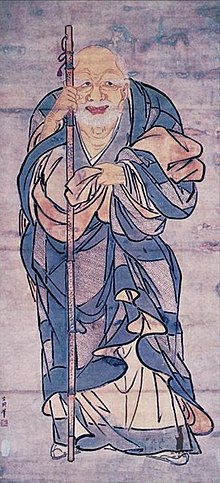Josui Sōen
Josui Sōen ( Japanese 如水 宗 淵 ; active from 1495 to 1499) was a Japanese monk painter of the Muromachi period .
life and work
Josui Sōen, also known simply as Sōen, was born in Sagami Province . He made it up to the high rank of a sutras keeper (蔵 主, Zōsu) of the important Zen temple Engaku-ji in Kamakura . Then he studied ink painting under Sesshu in Yamaguchi and returned to his temple with what he had learned.
Quite a large number of his paintings have come to us. They show a breadth of what is depicted, characteristic of a sesshū student who faced the requirements of a Zen temple. Undoubtedly, his artistic foundation is based on Sesshū in the type of contours and painting technique in general. Sōen's style, however, is softer than that of his teacher and differs in the way he creates atmospheric effects with the still wet ink.
In the Tokyo National Museum there is an ink painting of a landscape (破 墨 山水 図, Haboku Sansui-zu) from 1495, which is signed “Sesshū”. Sōen received it from Sesshū when he returned to Kamakura.
photos
Remarks
- ↑ Saint Batsudabara (跋陀 婆羅 菩薩) is shown. Owned by the Engaku-ji
- ↑ Huang Tingjian (黄庭坚, 1045–1105) Chinese calligrapher. Attributed to Sōen, Gotō Art Museum .
Individual evidence
- ^ Britannica International, Japanese
- ↑ Owned by the Okayama Prefecture Art Museum.
- ↑ a b Tokyo National Museum .
literature
- S. Noma (Ed.): Sōen . In: Japan. An Illustrated Encyclopedia. Kodansha, 1993, ISBN 4-06-205938-X , p. 1440.
Web links
| personal data | |
|---|---|
| SURNAME | Josui Sōen |
| ALTERNATIVE NAMES | 如水 宗 淵 (Japanese) |
| BRIEF DESCRIPTION | Japanese monk painter |
| DATE OF BIRTH | 15th century |
| PLACE OF BIRTH | Sagami Province |
| DATE OF DEATH | 16th Century |

